In case your time is short
- Priority 1 Incident Resolution: Targeting a Mean Time to Resolve (MTTR) and Mean Time to Restore under 4 hours for the most critical incidents.
- Tier 1 Resolution Rate: Aiming for a 60-80% incident resolution rate at Tier 1, reflecting a capable frontline defense and reducing the need for escalation.
- Staff Utilization Rate: Maintaining a rate of 60% or higher indicates efficient staff time allocation towards productive incident resolution.
- Average Staff Tenure: Striving for over 1 year to ensure stability and satisfaction within the NOC team, which translates to consistent performance.
- SLA Compliance: Achieving 95% or above monthly to maintain client trust and satisfaction with service delivery.
- Mean Time Between Failures (MTBF): Seeking an increasing trend over time to indicate enhanced network reliability and stability.
- Network Availability: Keeping consistently high and improving to minimize service interruptions and sustain business operations.
- Priority-Based NOC Time to Action: Aiming for an action initiation within 15 minutes of incident detection, to ensure rapid response to issues.
- Mean Time to Detect (MTTD): Targeting detection of operational issues under 1 minute, incorporating network impact and priority for efficient problem management.
- Individual's Ticket Edit Time: Monitoring for a decreasing trend over time, indicating growing efficiency in ticket management and update speed.
Table of contents
In this guide, we provide you with 10 Network Operations Center (NOC) performance benchmarks based on our own internal data to help you gauge your performance against ours.
Use these benchmarks as a diagnostic for identifying problem areas, planning enhancements, and articulating the opportunity in outsourcing part or all of your monitoring and management operations to a high-quality NOC service provider.
If you spot gaps between your performance and any of these benchmarks (or realize you have reporting gaps in general) connect with us to investigate further and explore support solutions.
Benchmark #1: Priority 1 NOC Mean Time to Resolve and NOC Mean Time to Restore
Under 4 hours
Priority 1 incidents are those that have the most significant impact on your operations and thus require the swiftest response. One of the key performance metrics to measure your NOC's efficiency in handling these Priority 1 incidents is the NOC Mean Time to Resolve (MTTR)—the average time taken by a NOC to address and rectify such an incident and restore the affected service. A lower P1 NOC MTTR signifies a more efficient NOC.
At INOC, we give special attention to the NOC Mean Time to Restore, which is the time taken by an engineer to pinpoint the source of a Priority 1 incident. To enhance our efficiency, we examine and eliminate the most likely cause of an incident first before moving to the next probable cause. In general, we’ve found that power outages, followed by fiber cuts, and then equipment failures in SFP are the most common causes of Priority 1 incidents we encounter.
This approach enables our engineers to save crucial upfront time before investing the additional time required for obtaining approval, procuring replacement parts, or other steps required for full incident resolution. While the true Mean Time to Resolve (often dependent on external factors like approval and delivery times) may not always be within a NOC's control, the NOC Mean Time to Restore for Priority 1 incidents remains a critical and controllable performance measure.
"Mean Time to Resolve is a critical metric, but it's important to recognize that for most NOC clients, we have limited control over it. Factors like fiber cuts or cable cuts can significantly impact resolution time, making it crucial to manage the process effectively rather than focus solely on a specific MTTR number."
— Peter Prosen, VP of NOC Operations, INOC
💡 A few operational questions for self-assessment
- How frequently are Tier 1 and Tier 2 teams trained, and are they provided with regular upskilling opportunities to handle a wider variety of incidents? Are there specific incident types that regularly require escalation, indicating a training need?
- Is the escalation process clearly defined, and does it facilitate learning and capability development for lower-tier staff?
- Are there barriers within the escalation process that prevent lower-tier staff from handling certain incidents?
Benchmark #2: Tier 1 NOC Incident Resolution Rate
60 to 80%
At INOC, we categorize our teams into three tiers. Tier 1 primarily deals with initial event correlation, impact determination on infrastructure and services, and incident prioritization within established SLA timeframes, along with the responsibilities of Notification Support. Tiers 2 and 3 focus instead on more advanced troubleshooting.
The Tier 1 NOC Incident Resolution Rate measures the percentage of incidents that the Tier 1 support team can resolve independently, without escalation. A high resolution rate at the Tier 1 level indicates a proficient and knowledgeable frontline defense supported by a well-structured operation. It’s a direct reflection of the team's capacity to handle a variety of incidents without requiring escalation.
A lower Tier 1 NOC Incident Resolution Rate can lead to an escalation of issues to higher tiers, increasing costs and utilization of advanced engineers. This escalation can extend resolution times, potentially hurting customer satisfaction.
We follow an escalation and training model to intentionally maintain and improve Tier 1 performance. When a lower-tier team member encounters an issue beyond their capability, they initially escalate it. Higher tiers not only resolve the problem but also train lower-tier staff on the solution, enabling them to handle similar issues independently in the future. This continuous learning process enhances the skill set of our Tier 1 (and 2) teams, enabling them to tackle a broader range of issues. As a result, we resolve most issues before reaching senior staff members, allowing them to focus on more complex problems.
"Tier 1 NOC Incident Resolution Rate is an important benchmark that we continuously strive to improve. By empowering our lower-tier teams and providing them with the knowledge and tools to handle incidents effectively, we aim to minimize escalations and achieve a high resolution rate within the NOC itself."
— Peter Prosen, VP of NOC Operations, INOC
💡 A few operational questions for self-assessment
- How frequently are Tier 1 and Tier 2 teams trained, and are they provided with regular upskilling opportunities to handle a wider variety of incidents? Are there specific incident types that regularly require escalation, indicating a training need?
- Is the escalation process clearly defined, and does it facilitate learning and capability development for lower-tier staff?
- Are there barriers within the escalation process that prevent lower-tier staff from handling certain incidents?
Benchmark #3: Staff Utilization Rate (on active incidents)
60% or higher
Staff Utilization Rate measures the proportion of time that NOC staff allocate towards productive activities (working issues). A higher rate demonstrates an efficiently operating NOC team.
The focal point here is the utilization rate, specifically on active incident resolution, considering that staff members might be engaged in other activities such as training or paid time off. Engineers may also devote considerable time to auxiliary tasks, such as phone communications, ticket generation, and lookup between working on incidents. Given that these activities often go unrecorded, the accuracy of the tooling used for tracking should be factored into this KPI assessment.
To optimize staff utilization, we adopt a multi-pronged strategy:
-
Automation of Routine Tasks: We automate repetitive tasks, such as notification emails, to streamline operations and free up engineers' time for more complex issues.
-
Data-Driven Staffing: By adjusting staffing levels to align with historical data indicating busy or slower periods, we ensure optimal productivity and reduced stress levels among staff.
-
Incident Tracking: We monitor which incidents our engineers are addressing and the duration of engagement to ensure they maintain consistent productivity rather than idly awaiting tasks.
-
Active Edit Time Measurement: To avoid inaccuracies from tracking time spent between incidents or on other activities, we measure the 'active edit time' specifically—the time engineers are actively working on resolving incidents.
These strategies not only contribute to improved productivity but also to a more manageable work environment.
📄 Read our other guide—NOC Performance Metrics: How to Measure and Optimize Your Operation—for more on measuring commonly overlooked staff utilization metrics.
"Staff Utilization Rate is a key metric that we find teams seldom track or use to its full potential. It's crucial to strike a balance between workload and available resources. We aim for a utilization rate of 60% or higher, accounting for planned time off and training, as well as considering the accuracy of our tools and the time required for incident transitions."
— Peter Prosen, VP of NOC Operations, INOC
💡 A few operational questions for self-assessment
- Are there routine, time-consuming tasks that your NOC staff are currently performing manually that could be automated?
- Is your staffing level in line with the volume and timing of work based on historical data? Are there predictable patterns of busy or slow periods during which you could adjust staff levels to optimize productivity?
- Are your engineers effectively allocating their time towards working on incidents, or are there excessive periods of downtime between incidents or time spent on unproductive tasks?
- Is the 'active edit time' consistently tracked and optimized to ensure efficient utilization of staff time?
Benchmark #4: Average Staff Tenure in Position
Over 1 year
Average Staff Tenure in Position is a significant indicator of staff stability and satisfaction within the organization. Maintaining a low staff turnover signifies a conducive work environment and high levels of employee satisfaction, which, in turn, contributes positively to the overall performance of the NOC.
Excessive staff turnover can inflict both tangible and intangible costs on the business. Tangible costs include increased expenses related to recruitment and training of new staff. The intangible costs, often overlooked, include loss of organizational knowledge and expertise that departing employees take with them, as well as potential service disruptions that could occur during the transition period. A higher average tenure implies reduced turnover, mitigating these risks and costs.
At INOC, we strive to exceed this benchmark by nurturing a positive work culture, delivering competitive pay packages, and fostering opportunities for professional growth. These efforts help us ensure that our employees feel valued and fulfilled, thus contributing to the high performance of our NOC.
These strategies not only contribute to improved productivity but also to a more manageable work environment.
📄 Read our other guide—How to Build and Manage an Effective NOC Team
—for a few of our best practices on building outstanding NOC teams.
"We've got team members who've been with us since the beginning, honing their skills and becoming real troubleshooting experts. Companies really have to be intentional about creating opportunities for staff to find and develop passion for this work they want to pursue—and then support them in doing so."
— Peter Prosen, VP of NOC Operations, INOC
💡 A few operational questions for self-assessment
- Are you cultivating a positive work environment and offering competitive compensation to retain your talent?
- Do you provide adequate opportunities for professional advancement and skill development that align with employees' career goals?
- Are you proactively addressing employee feedback and concerns to enhance job satisfaction and commitment?
Benchmark #5: SLA Compliance
95% or above monthly
Maintaining high adherence to Service Level Agreements (SLAs) is indispensable to preserving client trust and ensuring their satisfaction. It's a clear reflection of your commitment to delivering the promised level of service consistently.
Failing to meet SLAs can lead to client dissatisfaction, potential financial penalties, and tarnish your company's reputation. It's crucial to remember that while 100% SLA adherence is the ultimate goal, it's often challenging to achieve without a dedicated and very high-cost service model. Many organizations find these dedicated services cost-prohibitive as they often end up paying for staff downtime in addition to active incident management in order to achieve near-perfect performance consistently.
At INOC, we pride ourselves on achieving a 95% SLA compliance rate consistently each month. We attain this benchmark by rigorously monitoring our performance metrics, implementing robust operational processes, and continuously refining our service delivery model to better meet our clients' needs.
We deliver much of our NOC service through a shared model that balances cost and efficiency. This model is designed to strive for consistent SLA adherence, offering excellent value by achieving 95% SLA compliance while staffing is optimally adjusted for peak productivity. In most cases, it strikes an optimal balance in delivering high-quality services while maintaining cost-effectiveness.
📄 Read our other guide—NOC Service Level Agreements: A Guide to Service Level Management—for a deep dive into SLAs in the NOC.
"Perfect SLA adherence is of course what we pursue. But achieving higher than 95% availability consistently requires a very expensive set of resources that simply doesn’t make practical sense for most organizations. Our shared NOC support model does maintain that 95% benchmark, which is excellent performance without requiring such costly solutions."
— Peter Prosen, VP of NOC Operations, INOC
💡 A few operational questions for self-assessment
- Do you have robust processes in place for continuously monitoring SLA adherence? Are these processes reviewed and updated regularly to match evolving client needs and expectations?
- Are you consistently reviewing and refining your service delivery model to improve SLA compliance? Are changes implemented based on analysis of past performance, client feedback, and changes in the business environment?
- How well are you balancing the demands of achieving high SLA compliance and maintaining cost-effectiveness? Are there strategies in place to optimize staffing for peak efficiency without unnecessarily increasing costs?
Benchmark #6: Mean Time Between Failures (MTBF)
Increasing over time
MTBF is an essential indicator of network reliability and stability. An upward trend over time demonstrates an increase in the robustness of your network, thereby signaling enhanced operational efficiency.
Network failures can lead to significant business disruptions, impacting customer satisfaction and potentially causing reputational damage, client attrition, and loss of revenue. Therefore, it's critical to strive for a consistently increasing MTBF regardless of how long it is at any point in time.
It's worth noting, however, that not all NOCs have the capacity to measure MTBF. This can largely depend on their network environment, as numerous external forces beyond their control may influence network performance.
At INOC, for those customers where we can track this metric, we work diligently to ensure an increasing MTBF trend. This is achieved by ongoing improvements to network architecture, establishing robust redundancy protocols, and proactively addressing potential vulnerabilities through regular maintenance and monitoring. These proactive measures play a vital role in mitigating network failures and sustaining customer confidence in our services.
📄 Read our other guide—8 Tips for Reducing MTTR and Increasing MTBF in Optical Networks.
"MTBF in our network depends on various factors, especially when external elements come into play. The truth is, while it’s important to track, MTBF it can be a fraught NOC measurement because it involves external players and uncontrollable variables. It should be increasing, but sometimes what brings it down doesn’t have to do with the NOC at all."
— Peter Prosen, VP of NOC Operations, INOC
💡 A few operational questions for self-assessment
- How often do you review and enhance your network architecture to improve its reliability and resilience?
- Do you have effective redundancy measures in place to ensure network stability in the event of a failure?
- Are you proactively conducting regular network maintenance and monitoring to detect potential issues before they cause a failure? How efficient is this process in preventing network failures?
Benchmark #7: Network Availability
Consistently high and increasing over time
Network availability is critical for ensuring seamless business operations and minimizing interruptions in service. However, it's important to note that the absolute control over this metric often lies outside of a NOC's purview, since they don't typically own the entire network infrastructure. As such, total assurance of high network availability can be challenging to deliver solely from the NOC’s perspective.
Suboptimal network availability can result in disruptive downtime, decreased productivity, and unsatisfied customers. Such shortcomings can lead to detrimental effects on your company's profitability and reputation.
At INOC, we strive to optimize this benchmark through multiple strategies:
-
We employ a robust and resilient network architecture, which includes the deployment of redundant systems to maintain network stability even in case of a component failure.
-
We recommend preventive maintenance as part of our process to further bolster network reliability.
-
We continuously monitor network availability and record that data. This valuable information aids problem managers in identifying recurring issues and pinpointing vulnerabilities within the network infrastructure.
By providing these insights and recommendations, we enable the continuous enhancement of network availability over time.
"Network availability is impacted by the NOC, but it’s another metric that’s outside the NOC’s total control. The NOC doesn’t own the entire network, so we can't guarantee everything. But if you want a reliable network, we'll show you how to build one. It requires redundancy and backup power, like data centers do. Resilient networks are possible, but you have to invest in building them. Our NOC's role is to restore redundancy in high availability networks swiftly. It's about prioritizing availability and quick recovery."
— Peter Prosen, VP of NOC Operations, INOC
💡 A few operational questions for self-assessment
- Are you effectively monitoring and tracking your network availability over time to identify trends and issues that could potentially impact the network performance?
- Do you have a robust and redundant network architecture in place to ensure high availability even when certain components fail?
- Are you conducting regular preventative maintenance to proactively address potential network vulnerabilities and improve network availability?
Benchmark #8: Priority-Based NOC Time to Action
Under 15 minutes (monthly average)
Time to Action reflects the speed at which the NOC can detect an incident and commence remediation. A swift initial response is crucial for promptly mitigating issues and minimizing their impact on operations.
Lagging response times can contribute to prolonged system downtime and lost productivity, ultimately diminishing customer satisfaction.
INOC maintains this performance benchmark by harnessing the power of advanced monitoring tools, cultivating a well-prepared and responsive NOC team, and utilizing streamlined alert and notification systems. Our focus, regardless of incident volume, is to automatically prioritize incidents so that critical incidents get the attention they need from the start. Non-critical incidents can wait since the impact on services is not as critical to the business. to ensure immediate attention and quick response to every incident.
"Automation is key to efficient incident handling. Our standard practice is to auto-resolve incidents if everything clears up within 15 minutes. It's about letting the system take care of itself and notifying the customer without any manual intervention. We're exploring automation further, like resetting access points automatically after a short downtime. Why rely on human effort when the system can handle it swiftly and efficiently?"
— Peter Prosen, VP of NOC Operations, INOC
💡 A few operational questions for self-assessment
- Are you effectively monitoring and tracking your network availability over time to identify trends and issues that could potentially impact the network performance?
- Do you have a robust and redundant network architecture in place to ensure high availability even when certain components fail?
- Are you conducting regular preventative maintenance to proactively address potential network vulnerabilities and improve network availability?
Benchmark #9: Mean Time to Detect (MTTD) incorporating Network Impact and Priority
Under 1 minute
MTTD reflects the agility of a NOC in identifying operational issues. This benchmark is pivotal because swift and accurate issue detection translates into faster resolution times, minimized downtime, and heightened customer satisfaction.
A prolonged MTTD can result in extended incident resolution durations, escalating downtime, and consequently, eroding customer satisfaction.
INOC maintains this benchmark by leveraging cutting-edge monitoring tools, streamlined alerting systems, and a highly trained workforce. Our NOC uses AIOps to comprehensively analyze all incoming alarms, consolidate them for existing issues, or initiate a new incident in ServiceNow. In tandem with this automation, the system also determines incident priority, assisting engineers in strategizing an appropriate response and employing correlation to trace the incident's origin.
To balance rapid incident detection with the potential for false positives, depending on client preferences, we might defer the commencement of incident detection measurement until the issue has persisted for a specified duration. This approach aids in preventing alarm inundation due to quickly self-resolving issues.
"Detection of incidents and understanding their priority go hand in hand these days. In our new system, detection is basically instantaneous, with network impact and priority being assessed within seconds. We've achieved an average time to detect and ticket of under one minute, thanks to AI-powered correlation and accurate event detection. We also employ buffer times to control for false positives and ensure timely response. The NOC's incident response time has significantly improved in our system."
— Peter Prosen, VP of NOC Operations, INOC
💡 A few operational questions for self-assessment
- Are you employing advanced monitoring tools and efficient alerting systems to ensure rapid detection of incidents?
- Is your team trained to understand the importance of MTTD, and how it affects the overall performance of your NOC?
- Have you established systems to prevent false positives from skewing your MTTD statistics, such as delaying incident detection measurement for minor, quickly resolving issues?
Benchmark #10: Individual's Ticket Edit Time (Average)
Decreasing over time
The Individual's Ticket Edit Time benchmark gauges the average duration a NOC engineer spends on modifying or updating a ticket. A decreasing trend in this time frame indicates heightened efficiency in ticket management and swifter updates.
An escalated average time per ticket edit may lead to slower ticket updates, reduced staff efficiency, and potentially extended incident resolution times. However, it's crucial to recognize that speed does not equate to quality when it comes to ticket edits.
INOC achieves this benchmark by deploying efficient ticketing tools, implementing standardized ticket management processes, and providing thorough training on ticket management best practices to our staff.
When staff transitions into different roles or when we onboard a new team member, we closely monitor the trend in their individual average edit time. Typically, during the initial three months of commencing a new role or working with a new client, an engineer's edit time tends to be longer, eventually reducing and stabilizing over time.
Should this trend deviate, we examine whether the engineer might require additional training or whether there are gaps in their understanding. Another key performance indicator we consider is an individual's ability to execute quality edits. Our ultimate aim is to cultivate a team capable of efficiently delivering high-quality resolutions.
"For individuals, there's a metric we want to hit, but it also depends on each person and what they’re doing. In the first three months, we expect the edit time to decrease as they get used to the system and clients. It's important to consider quality along with edit time. Some people may take longer but deliver better quality. For example, our help desk has a target of a five-minute average edit time. Service desk and troubleshooters have varying averages depending on complexity and priority. We don't have a specific benchmark for the number of edits per hour as it is workload-dependent. However, we monitor the average number of tickets processed per shift or day, along with the average edit time, to ensure efficiency."
— Peter Prosen, VP of NOC Operations, INOC
💡 A few operational questions for self-assessment
- Are your team members being trained adequately on your ticketing system and processes to ensure they can update and modify tickets efficiently and accurately?
- Are individual ticket edit times being monitored and trends analyzed to identify if a team member needs additional training or support?
- Have you implemented automation and other tools to streamline the ticketing process and minimize manual labor, hence improving the average time per ticket edit?
Final Thoughts and Next Steps
Measuring NOC performance, let alone improving it, is one of the most common challenges we see and solve every day. Quantifying your performance efficiently and accurately is essential for any NOC to run more smoothly in the future.
Without actionable NOC metrics, teams nearly always struggle to hit their service level targets and break out of a constant state of busyness. These measurements are instrumental in pinpointing where inefficiencies lie and what you can do to address them.
At INOC, we strive for maximum visibility of each NOC environment we support, tracking metrics and deploying the latest tools to enable continual service improvement—increasing efficiency over time while meeting SLAs and SLOs consistently.
Talk to us when you’re ready to:
- Report on key metrics. Reveal the critical metrics missing from your operation and paint the full picture of availability, quality, security posture, and more. We combine KPI reporting with a broader set of utilization metrics that bring additional data and context into view.
- Rapidly improve those metrics. Our structured approach to NOC support organizes the operation and enhances performance against your service level targets—lightening the load on advanced engineers while working and resolving issues faster and more effectively.
- Drive operational maturity. We employ the latest in machine learning and automation to identify and automate low-risk tasks, unlock efficiencies, and continuously improve performance and consistency across the entire operation.
Whether you're working to implement these practices or looking to enhance your existing NOC operations, achieving and maintaining operational excellence requires both expertise and dedicated resources. INOC offers two comprehensive solutions to help organizations maximize their NOC capabilities:
NOC Support Services
Our award-winning NOC support services, powered by the INOC Ops 3.0 Platform, provide comprehensive monitoring and management of your infrastructure through a sophisticated multi-tiered support structure. This advanced platform combines AIOps, automated workflows, and intelligent correlation to help you:
- Achieve maximum uptime through proactive monitoring and accelerated incident response
- Reduce manual intervention with automated event correlation and ticket creation
- Scale your support capabilities without the complexity of building internal NOC infrastructure
- Access real-time insights through a single pane of glass for efficient incident and problem management
- Leverage our deep expertise across technologies while maintaining complete visibility through our client portal
NOC Operations Consulting
Our consulting team provides tactical, results-driven guidance for organizations looking to optimize their existing NOC or build a new one from the ground up. We help you:
- Assess your current operations and identify opportunities for improvement
- Develop standardized processes and runbooks that enhance efficiency
- Implement best practices for event management, incident response, and problem management
- Design scalable operational frameworks that grow with your business
- Transform your NOC into a proactive, high-performance operation
Read our case studies and other resources for more expert insights into NOC support. Contact us and get the conversation started.
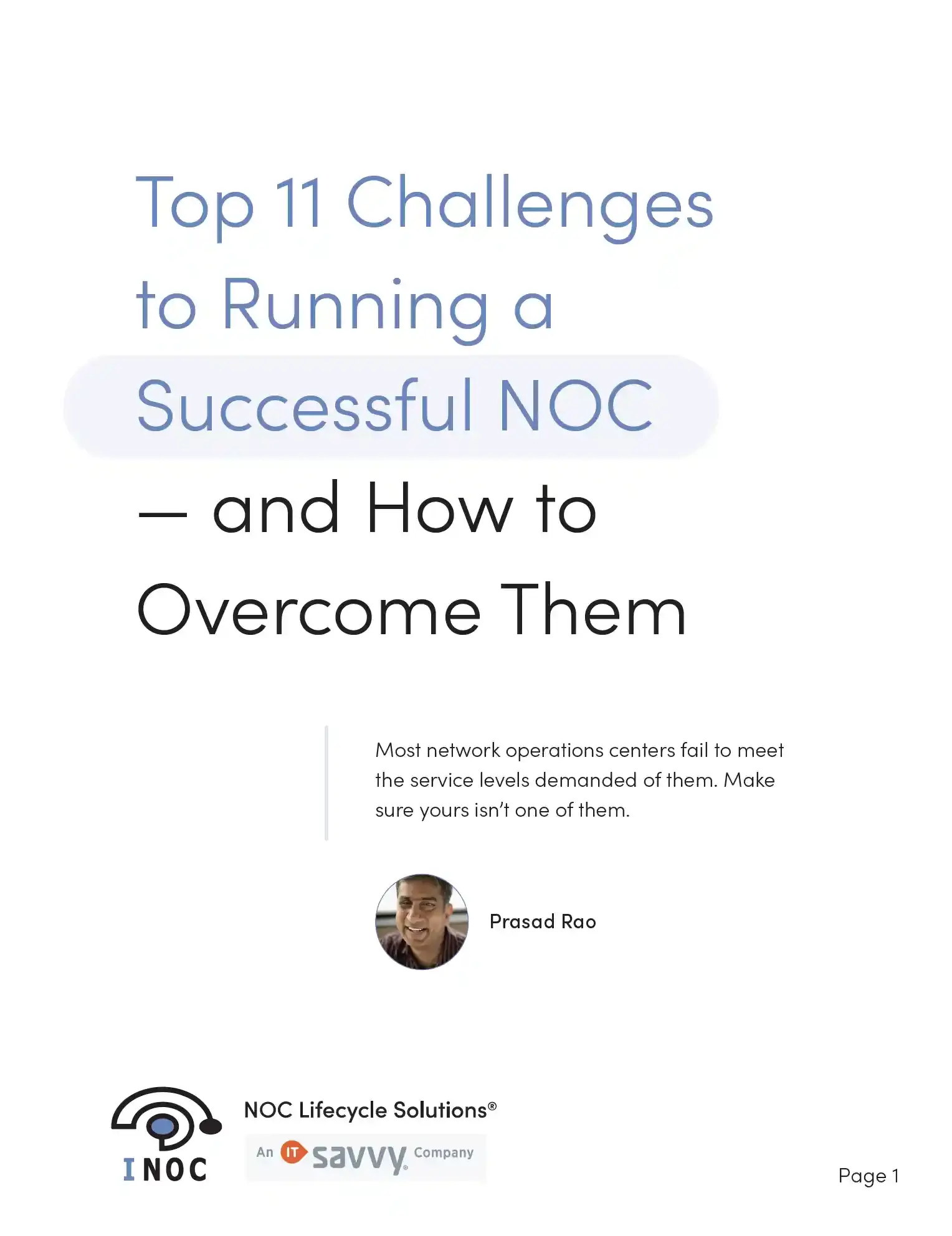
Free white paper Top 11 Challenges to Running a Successful NOC — and How to Solve Them
Download our free white paper and learn how to overcome the top challenges in running a successful NOC.



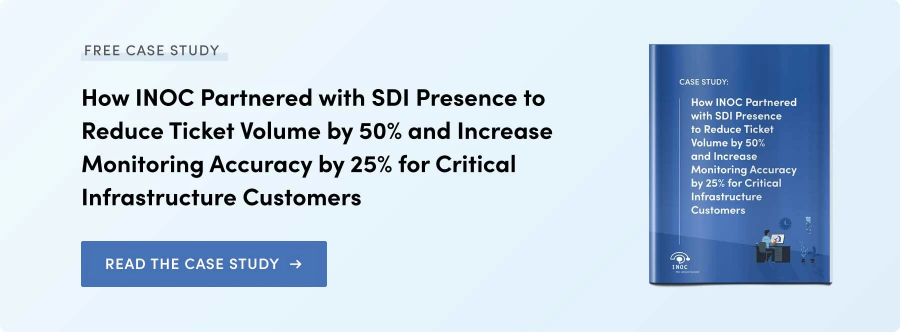



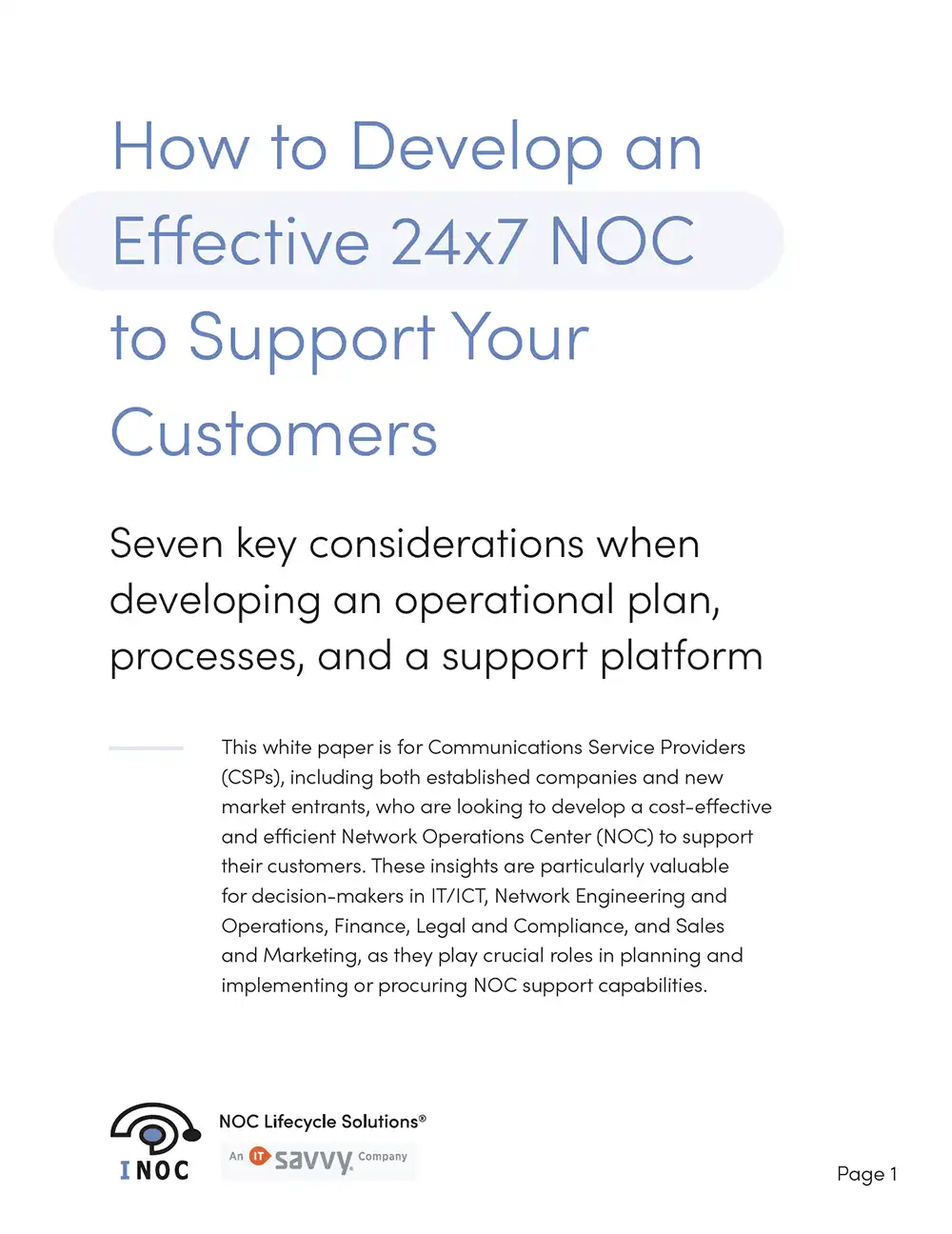

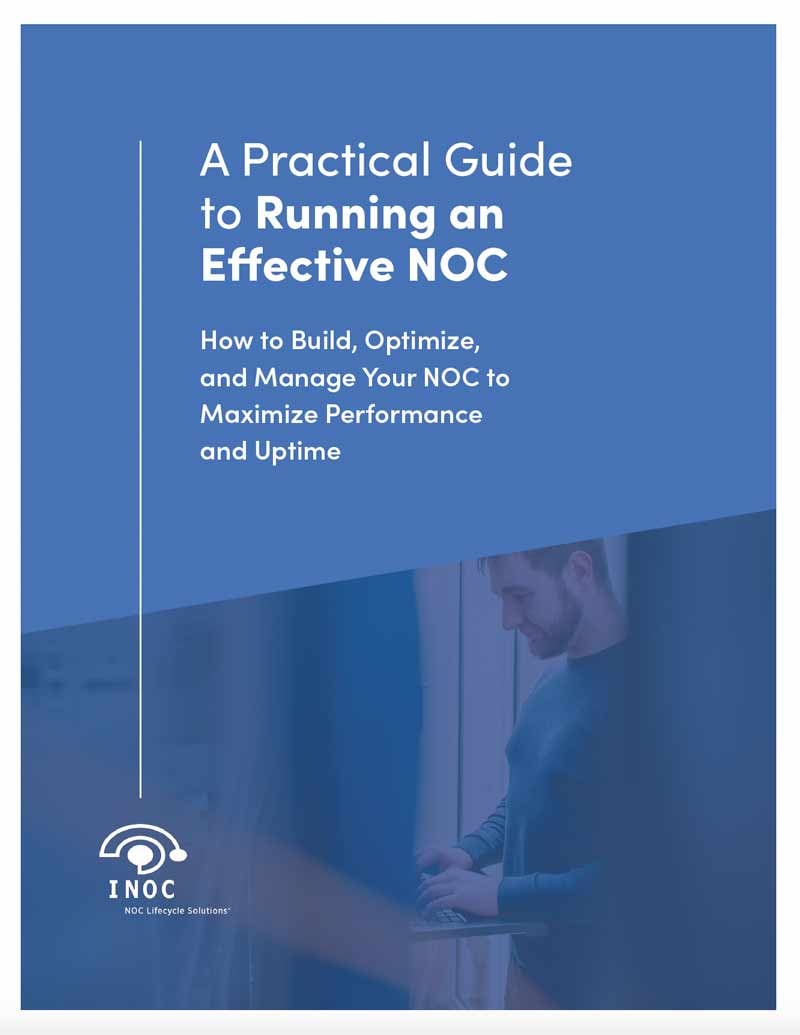
-images-0.jpg?height=2000&name=ino-WP-NOCPerformanceMetrics-01%20(1)-images-0.jpg)


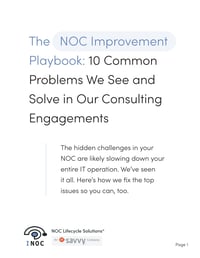
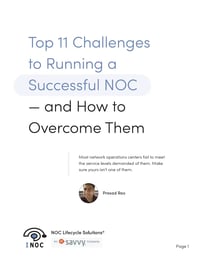
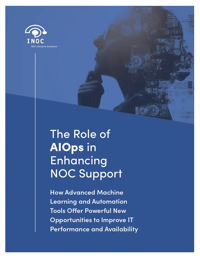
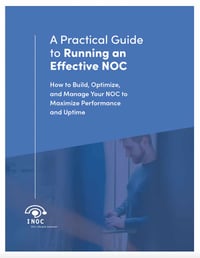
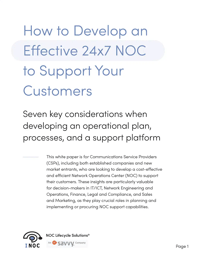
-images-0.jpg?width=200&height=259&name=ino-WP-NOCPerformanceMetrics-01%20(1)-images-0.jpg)